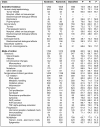Text mining for literature review and knowledge discovery in cancer risk assessment and research
- PMID: 22511921
- PMCID: PMC3325219
- DOI: 10.1371/journal.pone.0033427
Text mining for literature review and knowledge discovery in cancer risk assessment and research
Abstract
Research in biomedical text mining is starting to produce technology which can make information in biomedical literature more accessible for bio-scientists. One of the current challenges is to integrate and refine this technology to support real-life scientific tasks in biomedicine, and to evaluate its usefulness in the context of such tasks. We describe CRAB - a fully integrated text mining tool designed to support chemical health risk assessment. This task is complex and time-consuming, requiring a thorough review of existing scientific data on a particular chemical. Covering human, animal, cellular and other mechanistic data from various fields of biomedicine, this is highly varied and therefore difficult to harvest from literature databases via manual means. Our tool automates the process by extracting relevant scientific data in published literature and classifying it according to multiple qualitative dimensions. Developed in close collaboration with risk assessors, the tool allows navigating the classified dataset in various ways and sharing the data with other users. We present a direct and user-based evaluation which shows that the technology integrated in the tool is highly accurate, and report a number of case studies which demonstrate how the tool can be used to support scientific discovery in cancer risk assessment and research. Our work demonstrates the usefulness of a text mining pipeline in facilitating complex research tasks in biomedicine. We discuss further development and application of our technology to other types of chemical risk assessment in the future.
Conflict of interest statement
Figures











 , Wilcoxon rank sum test).
, Wilcoxon rank sum test).

References
-
- Ananiadou S, McNaught J. Norwood, MA: Artech House, Inc; 2006. Text Mining for Biology And Biomedicine.
Publication types
MeSH terms
Substances
LinkOut - more resources
Full Text Sources

